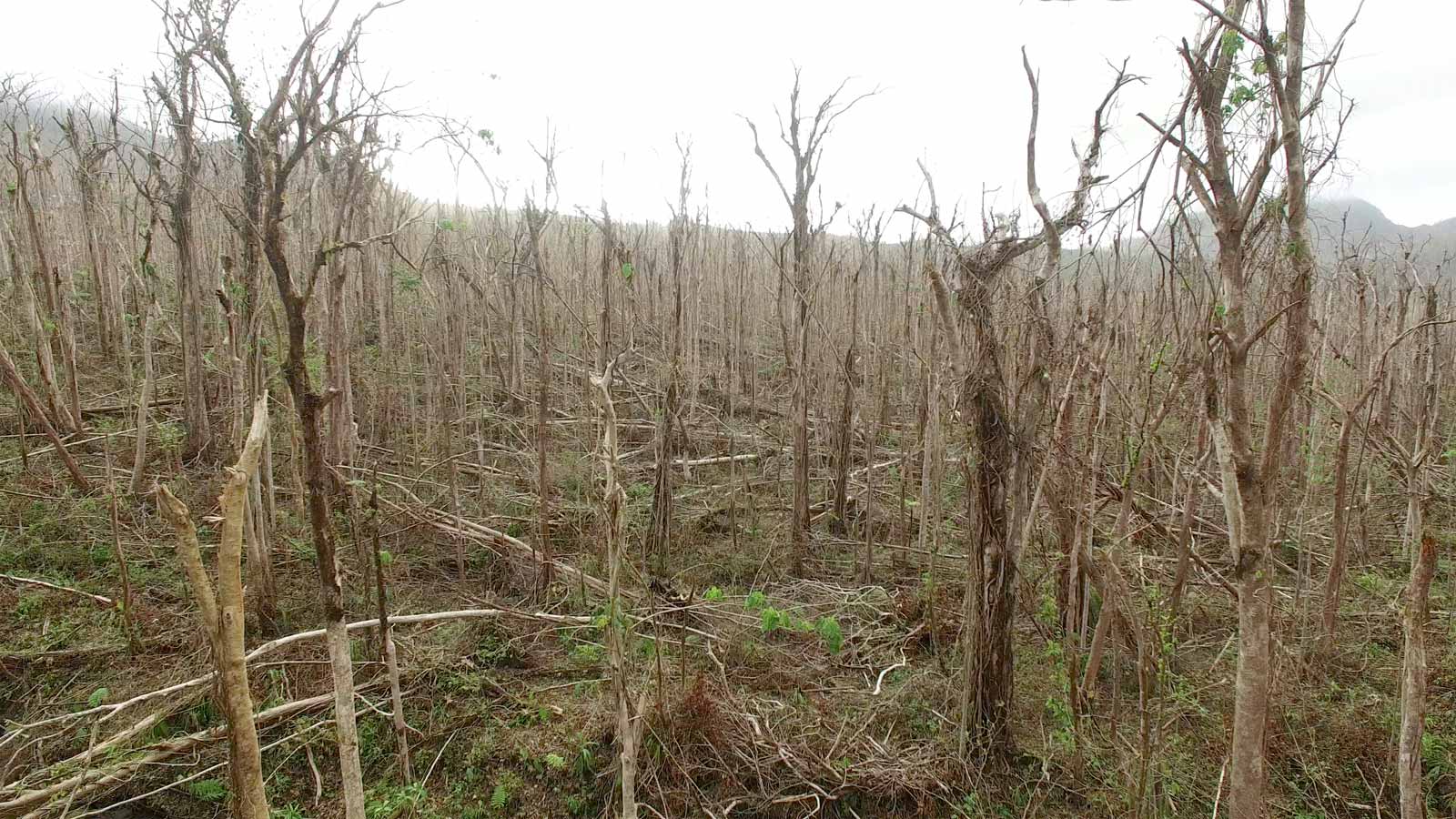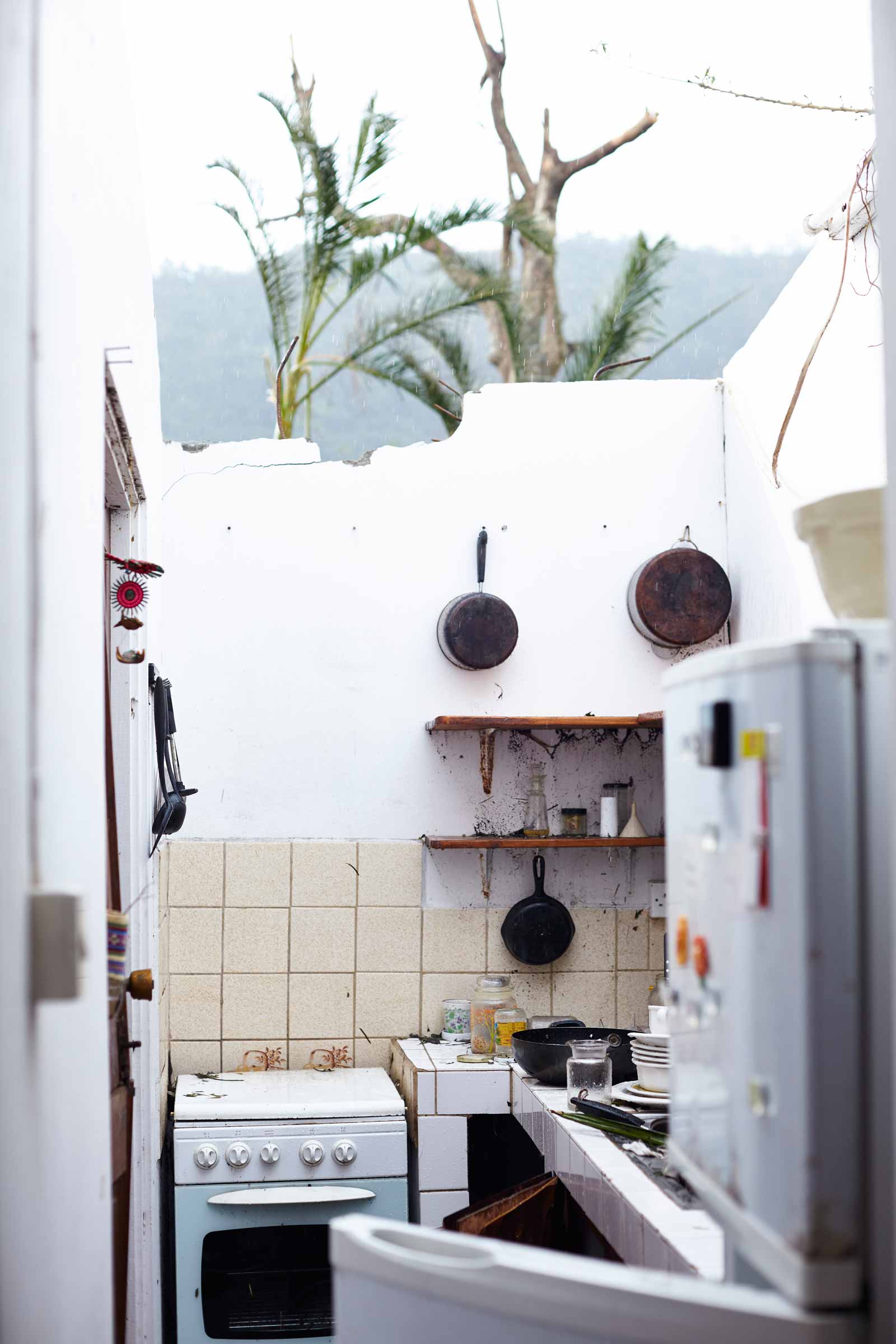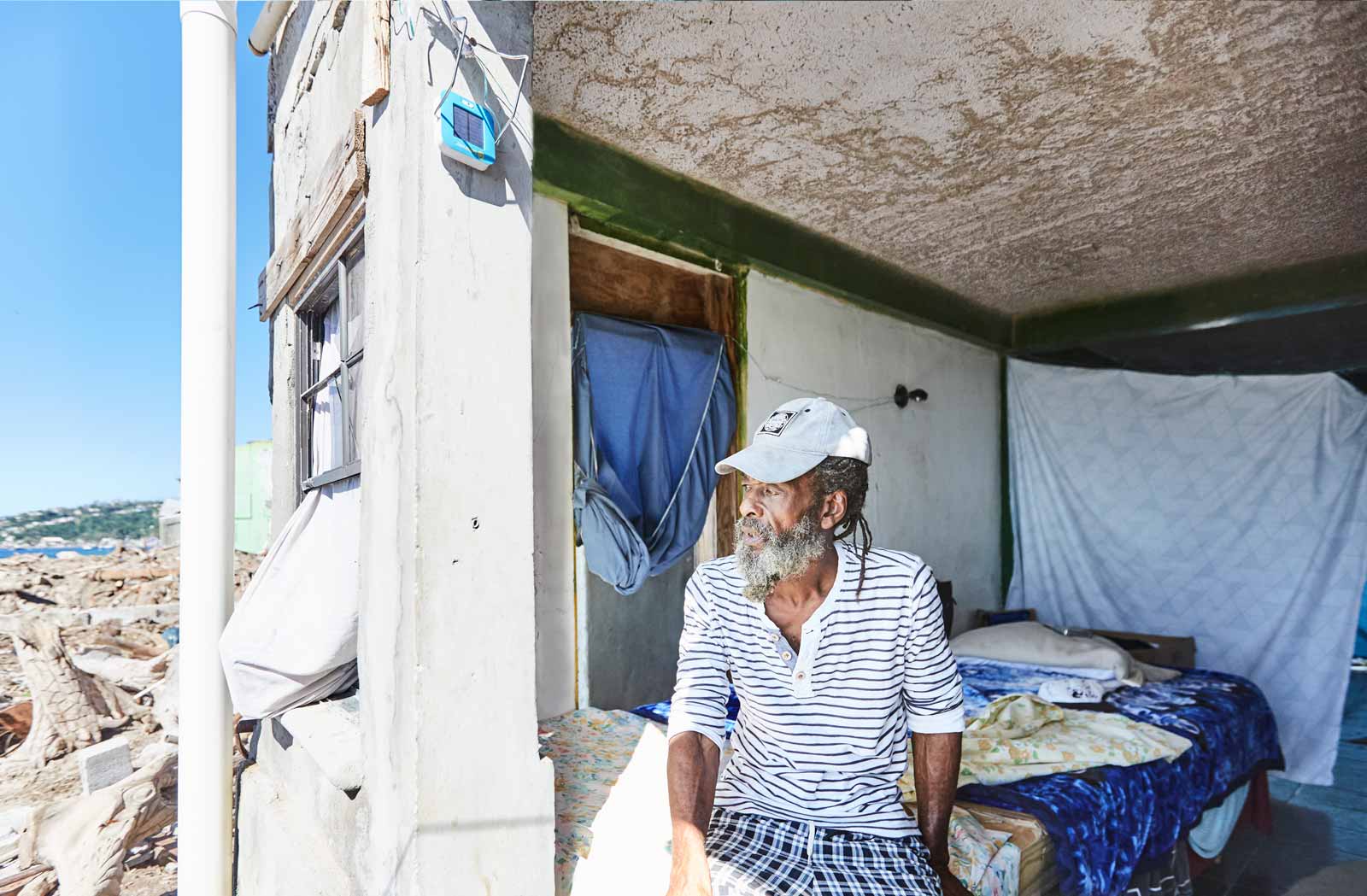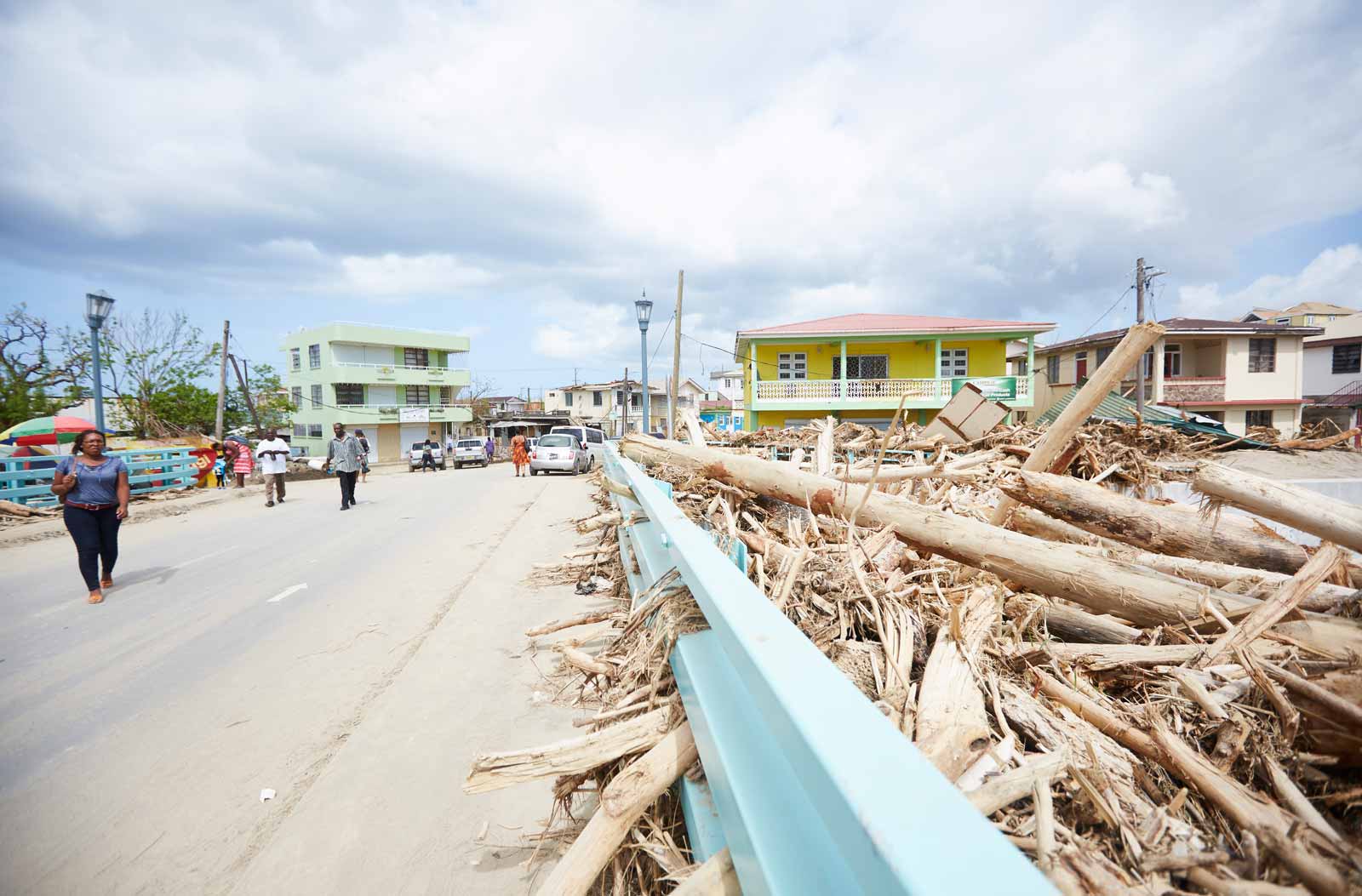Lennox Honychurch wrote the book on Dominica. Born on this small, mountainous island in the Windward Antilles in 1952, he first published The Dominica Story in 1975. An updated version of the book remains the standard history of a country that few Americans could distinguish from the Dominican Republic until recently, when Hurricane Maria blasted its peaks with 160-mile-per-hour winds and images on the news showed a once-lush land that then resembled the surface of the moon.
Located between the French islands of Guadeloupe and Martinique, Dominica was named for the day of the week—a Sunday—when Columbus first glimpsed its steep sides. The island— which is just under 300 square miles, about the size of New York City—remained unsettled by Europeans for much longer than its neighbors; it remains home today to a proud community of indigenous people whom the Spanish dubbed “Carib” but who call themselves Kalinago. The island passed back and forth between French and English control many times before it became, in 1763, the British colony it would remain until winning independence in 1978.
Honychurch’s roots there go back generations, and his devotion to Dominica has made him work to restore its colonial-era forts and to write several more books. His most recent is a study of how Dominica’s “maroons,” or runaway slaves, once thrived in the still-untamed woods of what the local tourist board now touts as “the Nature Island of the Caribbean.”
On the afternoon of September 18, as Hurricane Maria bore down, Honychurch was in his home by the island’s north shore. The next day, after the storm had moved on and was raging toward Puerto Rico, I tried to reach him on his cellphone. My call went straight to voicemail. Dominica’s power grid was wrecked, and its few cell towers were snapped in half: the only way to communicate with anyone there, for weeks after the storm, was via email or Skype with those who had access to government computers in the island’s little capital, Roseau. From friends there, I soon learned that Honychurch was all right. He’d built his house—unlike most homes on an island where nine in ten abodes saw severe damage—using traditional hurricane defenses; it had stood firm. But it wasn’t until seven weeks after the storm that I finally reached him—with the help of a temporary cell-tower, Honychurch explained, that the phone company has erected near his village.
“We had what you’d call a ‘mixed preparedness’,” he sighed, explaining that many of his neighbors hadn’t absorbed Maria’s full danger until the storm hit. “On the US cable TV stations, where many people here get their news, ‘making landfall’ means hitting Florida or Puerto Rico; they don’t focus much on the littler islands that Atlantic hurricanes hit first.” Honychurch told me his story of experiencing the worst storm ever to strike his island. He described the steep uphill battle that Dominica is still facing three months later, after the most damaging Caribbean hurricane season on record. Even to begin a rebuilding process will take years, and in the meantime, the world’s spotlight moves on. (Our conversation has been condensed.)
—Joshua Jelly-Schapiro
Joshua Jelly-Schapiro: I wonder if you could describe for me the day Maria hit, the buildup to the storm, and your experience of it. Were people in Dominica ready, in any way, for what hit them?
Lennox Honychurch: Most people weren’t, no. Right up until Maria’s outer bands began to hit, many people here hadn’t realized the enormity of her approach. There was still talk on local radio, that afternoon of September 18, of Maria moving more to the south, toward Martinique. But by 8:00 or so that evening, as it got really bad, it became clear to all that this was indeed a Category 5 hurricane, hitting us full force, and that it was going to go diagonally across the whole island.
We’ve had bad hurricanes before. Hurricane David, in 1979, was a landmark in the twentieth-century history of Dominica. But it’s amazing how time wipes away memory. As Maria landed, many people went to so-called hurricane shelters—village schools and churches, mostly. But many of those buildings were built in the last couple decades with big flat roofs; they weren’t up to a storm like this. Their roofs came right off, and people were exposed.
You, though, were okay in your house, but what was that night like there? And what is it about your place, which I know you modeled on older French homes in the Antilles, that allowed it to stand firm?
I’m on headland facing north, and that night it was like being on the bow of a ship—the winds surging and waves crashing against the cliffs’ bottoms, rain pouring down. Gusts chopping up the trees like spinach. But I built my place to withstand storms and based it on the old houses the French learned to build on Martinique in the eighteenth century—they’d had a number of experiences there, by then, that taught them they had to be ready to withstand these storms that arrived, in the days before satellites and televisions, with no warning—when you had to be able to close up in ten, fifteen minutes. Their houses had heavy shutters. Mine has those, and a steep-pitched roof with rafters that are close together and have “hurricane ties” at either end. It’s built of actual boards rather than sheets of plywood. The galvanized [steel] on the roof is screwed in, not nailed. The houses here that weathered Maria were the old ones, or done in that style. It’s the houses built since the 1970s and 1980s, these places made from just nailing together plywood and particle board—including many homes of the upper classes, not just the poor—that got destroyed.
Advertisement
When you opened your door, the morning after, what did you see?
Well, it was just after first light at 6 AM that I opened my door—to a completely new vista. I had been surrounded by coastal forest, but that was completely gone—I was looking across to houses, though now demolished, that I knew were there but that I had never seen from my place before. The landscape was completely transformed, returned to how it would have looked 200 years ago, when the island’s coasts were all planted with sugarcane. You could see for miles. Except for the ground, of course, was covered not with sugar but with branches. My neighbors, beginning very early that morning, began to arrive. I was one of the few people on the island who didn’t lose water or power. My concrete cisterns were full; the solar panels bolted to the roof held. And so those first few days, especially, my community service was just to be available for people coming for showers and for water; for ice and electric current.
You live in the north of the island, the other end of the island from Roseau. But I know that most of your family, your mother and sister, live in the south, up in the hills over the capital. But you had no way, in the aftermath of the storm, to reach them, right—no one did, since all phones were out, and I presume the roads were, too? There are, of course, only a few major roads in Dominica, whether you’re circling the coast or crossing the interior.
Yes, that’s right. And I was keen to head south right away, to see my mother. She was about to turn ninety-two—Maria hit on September 18 and my mum’s birthday was September 21. So I wanted to get there for that; also just to ensure that my mum, and my sister and my sister’s kids, with whom she lives, were okay. And there was no way of communicating with them but to go. But many of the roads, as you say, were washed out; those that weren’t were impassable. So I considered walking—it would have been some thirty-two miles on foot. But I met a man by my place, a couple days after the storm, who had just done sixteen miles, and he had started at 6 AM. So I realized there was no way I could walk across the island in one day—over tree trunks and through rivers, but also, now, dodging the electric poles and cables that were twisted and spun all over the place. So I waited until the road was partially open, a few days later. And I drove a way into the interior, as far as I could go, but I had to walk the rest, about ten miles.
I was very glad, as I did so, that other people had walked before. Because the roads were unrecognizable. It was thanks to those footsteps in the mud, their cutlass marks through branches, that I found my way. My mum and my sister and her kids, thankfully, were okay. They’d lost water and power. But they were okay. And that walk through the interior, seeing the devastation to the forest, was astonishing.
The trees, nearly all of them, were snapped off halfway up their trunks. But what was even more striking was how they’d been stripped, by the branches tearing through the forest and ripping off the bark, the orchids, everything. That, and the parrots—those that hadn’t died. They looked, on these stripped rainforest trees, like specks of emerald green. And you could just tell they didn’t know what had hit them. They were in a state of shock. In the weeks since, there’s been real concern about one of our native species here—the Imperial Parrot, which you find only in Dominica and which is on our national flag. Even before the hurricane, they were extremely rare, and the National Forestry folks haven’t reported seeing any since. Other parrots have come from the mountains to the coasts, whose flora are greening faster than our forests. In the trees by me now, we have red-necked parrots that we never had before—usually they live on the mountain.
Advertisement
Birds, of course, weren’t the island’s only traumatized inhabitants. Tell me about your encounters with people as you traversed the island that first time after the storm, and since.
Among the most striking experiences was passing through the Kalinago territory—the area where the indigenous Kalinago people live, on the Atlantic coast. It’s a part of the island that’s totally exposed to the elements, and the devastation there was awful. I talked with many people whose houses were just spread around like matchsticks. Since the island is so mountainous, most people live around its edges by the coast. But that also meant that all of our rivers—we have a saying here: “Dominica has a river for every day of the year”—did as much damage as the wind in many spots. The rivers brought down boulders, and huge trunks of trees like battering rams coming down flooded ravines. It was as though the island had vomited everything out onto its coastal villages.
People here are extremely resilient, and look after each other—in rural districts especially, we like to talk of “koudmen”: the spirit of helping hands. Living on this rough, rugged island, Dominicans are accustomed to nature’s fury, even if it isn’t a full-fledged hurricane. They have a remarkable capacity to just pick up, and piece together what they can—to go from having a three-room house to picking up the pieces and sheltering their families in one room instead. We’re also fortunate here, as damaging as the rivers were during the storm, to have them. In the Leeward Islands—Antigua, Barbuda—they don’t have such water; accessing fresh water, in those places, is really a chore. After Maria, our rivers may have been running murky, but at least people could wash their clothes. And they had access, too, to our springs. All over the island, I saw people putting plastic gutters from ruined homes down into springs to get fresh water—using bits of ruined houses to drink.
I know that many people, too, have just left. We’ve been hearing about that in many places—about how climate change, and awful storms made worse on a warming planet, are increasingly a driver of migration. What has that looked like, in recent weeks, in Dominica?
In the immediate aftermath, the ferry was providing a free service to Martinique and Guadeloupe, so many people took advantage of that. Many people have gone to Antigua, where Dominicans have long gone to look for work. And Antigua must be having a hell of a time—they’ve also got everyone from their sister-island, Barbuda, which was completely razed by Hurricane Irma. From my house on the north coast, I saw so many little fishing boats passing the point here, just crowded with people, leaving for the French islands or wherever else.
Thirty-eight years ago, Dominica’s population was the highest it’s ever been. The day before Hurricane David, in August 1979, our population was 85,000. After David, the next census, the population was 15,000 less, at 70,000. Before Hurricane Maria, we were down to about 68,000. And now, people have just been going in droves. We may be down, goodness knows, to maybe 45,000. But plenty of other people, of course, can’t leave. And many of our elderly, people in their eighties and nineties, have been dying recent weeks—expiring of a kind of broken heart, I think, from the shock of it all. The number of deaths has not been fully quantified. A couple of weeks ago, they were saying, “Twenty-four dead, thirty-four missing.” But with so many people living in forests and on isolated farms, you just don’t know. A lot of people were swept away.
The situation in rural areas is one thing, but a lot of the international coverage of what was happening in Dominica, especially right after the storm, focused on Roseau—this more urban area, where people depend more on shops than their own land or neighbors to eat. And Roseau isn’t even a city by world standards; it’s just a town, really, of 20,000 people. What was the situation there?
Well, as you say Roseau may not be a big city, but it is home to about a third of Dominica’s population. And there’s been a lot of chaos. The port was so damaged, as ships began to arrive with goods and aid, all these containers were being piled hither and yon. Finding what was in what, and what was meant for whom, and getting goods into shops, caused a great deal of dismay. Many of the shops were raided by hungry or thieving people. Many shopkeepers found it virtually impossible to open again, and some, especially Chinese or others not from Dominica, have just left. The picture with aid has, of course, been very difficult.
In Dominica, as in many other Caribbean islands, we call ourselves independent—we won independence from Britain in 1978—but on occasions like this, you really see how extremely dependent we still are on the goodwill and assistance of wealthy countries. And these countries’ focus, with all the damage done by hurricanes elsewhere, has been elsewhere, too. The US, after Maria, had Puerto Rico to deal with. The British had a ship in the region, but they had to deal with the British Virgin Islands. The French were already on the ground dealing with St. Martin and St. Barthélemy, after Irma, and helped Martinique and Guadeloupe prepare and deal with Maria, with the full force of the French government. No one has really focused on Dominica. Which was so different from when Hurricane David hit us in 1979. That time, the US came right away, the army and their engineers; the French; the British, of course. They each had an encampment here. But not this time.
Eventually, some aid arrived—but you’ve said that a lot of the rebuilding has been more at the grassroots; it’s been about local organizations and efforts, sometimes partnering with people abroad.
Yes, eventually, contingents from those various nations came to help. So did foreign aid workers from Unicef, UNESCO, the World Health Organization. But certainly, a lot of the work has been left to us. In my district, many children aren’t back in school. Hospitals and clinics that aren’t yet connected to power or running water are still doing what they do—delivering babies, tending to the sick and old, carrying on in hugely trying circumstances. I’ve been focused, personally, on distributing water filters to such clinics, and to individuals, too. An organization on [the island of] Grenada sent up a container full of these “Lifesaver” purifiers—they’re like jerry cans with filters, to help make river-water potable—that I went and picked up by the port, and have been distributing daily from the back of my pickup, along with packets of seeds the Grenadans also sent, to help our farmers who grow vegetables. Many people are doing things of this nature, with the help of family from overseas sending down supplies.
But the situation remains desperate. We need building materials, steel, and wood to put roofs on our schools. Of course, the utility companies are also going to have to make a huge reinvestment—they’ve lost so much in terms of cables and poles—and they’ll need help. Our basic infrastructure is shot. Which is why, now, our prime minister [Roosevelt Skerrit]’s job has become to seek assistance.
Right after the storm, Skerrit went to the UN and gave an eloquent speech in which he implored the richer countries, those whose carbon outputs have fed climate change, to help those countries most vulnerable to global warming’s effects.
Yes, and that’s a conversation about which we’re keenly aware. “To deny climate change,” as the prime minister put it, “is to deny a truth we’ve just lived.” Where his demands for help with readying islands like Dominica for storms will go, we’ll see—that’s a question for the long term. For now, the political situation is about seeking funding—it’s about going not just to the UN, but to Washington D.C., to various embassies and high commissions, trying to gain help. Getting the millions required for rehabilitation, one senses, won’t be easy. In 2017, there are problems around the globe that dwarf ours here. But we’ve got to make our voices heard.
Hurricanes are not new in the Caribbean. Here in Dominica, as I’ve been saying on local radio, we’ve had to deal with them many times in our history. The challenges, on our warming planet, have changed; the strength of this storm was exceptional. But we’ll rebuild this time, too. We’ve got no choice.





